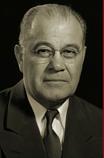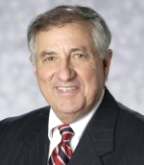Dr. Coyle E. Moore
By Jim Joanos
If you come to FSU, you will find the name “Moore” in a number of places. One of the most conspicuous places is the Moore Athletic Center which is the center of FSU athletics.
 |
Dr. Coyle E. Moore |
Dr. Coyle E. Moore came to Tallahassee in 1928 when the population of the town was about 10,500. He was fresh off having received a P.H.D from the University of Chicago. Prior to that he had earned degrees at The Citadel and the University of North Carolina. Born into a poor tenant farm family in South Carolina he rose to become an important figure in academics as well as the development of intercollegiate athletics at FSU. Early in his life with the encouragement of his father he had chosen academics as the path that would bring him success. He came to Tallahassee when he was hired as an associate professor at The Florida State College for Women, a prestigious Women’s college that is now “The Florida State University.” Dr. Moore commenced to rise in status along with the institution that he served. In time, he became a national figure of prominence in the field of Sociology as well as the dean of the Department of Social Welfare at FSU.
When World War II ended, FSCW became coeducational. Dr. Moore thought that intercollegiate athletics was very important if FSU was to rise in size and stature so he became imbedded in development of the intercollegiate athletic program. Dr. Moore had played football in high school and had been a member of the team in college. While he was working his way through his educational process, he had coached football at some high schools in order to add revenue to assist in the costs of obtaining his education.
Dr. Moore was on the frontline in supporting the beginning of the athletic program. When FSU began its program of intercollegiate athletics, Dr. Moore was appointed to its athletics committee and served for more than twenty years. On the committee he along with another Dean, Dr. Mode Stone, have been recognized as the most important members of that committee and in shaping the policies of FSU athletics. I had the opportunity to witness how effective they were on the athletic committee. For the school year 1950-51, I was the student representative on that committee.
During the four school years from 1953-57, my wife, Betty Lou worked as a student secretary in the office of the Department of Social Welfare that was headed by Dean Moore. Her description of Dean Moore is very positive: “I found him to be very involved in all areas of academics and athletics as well. In addition, he kept in contact with the happenings of the students, a trait rare among the faculty.”
As an important member of the athletic committee, Dr. Moore was responsible for the creation of one of college football’s most unique traditions, the Sod Cemetery. Before the FSU game at The University of Georgia in 1962, Dr. Moore was called upon to speak to the team. His talk ended with the charge that the team win and bring back some sod from “between the hedges.” That is what the team did. They upset Georgia 18-0 and FSU’s captains Gene McDowell and Red Dawson, both natives of the state of Georgia, remembered Dr. Moore’s challenge. They gathered up a small amount of sod and brought it back to Dean Moore. He kept the sod for a while and then after discussing it with head coach Bill Peterson and with team members they decided to create a cemetery and bury the sod near the football practice field. Later there were more underdog away games in which the bringing back of sod was repeated.
As the years went by and the number of “graves” increased, the cemetery became quite popular. In 1982, Dr. Moore selected Doug Mannheimer to take charge of the Sod Cemetery. Some major enhancements have been made since. The cemetery was moved to a location next to the football practice field. An ornate fence surrounds it and there are nice bronze plaques marking each grave. On home football game days, the plaques are adorned with flowers and festive ceremonies are presented. Normally a former player will give a talk.
When Dean Moore retired in 1968 as Dean and became Dean Emeritus, his spirit and support of FSU continued. While he was Dean, he had started a pattern of giving. The Moore’s were heartbroken when their son Coyle Jr., at age 27, died of cancer in 1961 and the Moore’s established a scholarship in his honor. Through the years there were many more financial donations to the university, a number of which were directed to athletics. At the time when he made a million-dollar contribution it was the first time ever that FSU had received a gift of that magnitude. Late in life he and Mrs. Moore setup The Moore Family Trust that continues to this day producing needed income for the Sod Cemetery and various other FSU programs.
In retirement he was a regular attender at various FSU games and other events. Back then, every Monday following each football game the Boosters held luncheons featuring Coach Bowden who would give a short talk and then answer questions. On most Mondays, Dr. Moore would ask a humorous question. One of the most remembered was following a game which FSU nearly lost in the waning moments of the game after installing a “prevent defense.” Dr. Moore’s question that week was simply, “What does a ‘prevent defense’ prevent?” I looked forward each week as to what question Dr. Moore would ask.
In addition to his involvement in beginning intercollegiate football at FSU, playing the University of Florida, his leadership on the athletic committee, his financial generosity, he was among the thirty or so that began the Seminole Boosters organization. Sometimes he has been referred to as the “architect” of the beginning of the FSU athletics program, a fitting description. At the dedication of the Moore Athletic Center, he has been quoted of having said this:
“As the sun sets in the west for me (and I hope that is slowly), shed no tears for me, for I have enjoyed life’s journey in which I have sought spiritual serenity and harmony amid the perplexities of life.”
Dr. Moore died in 1990 at the age of 89, leaving behind a legacy of service and support to FSU that may never be surpassed.
About the author:
 |
Jim Joanos |
Memories of Garnet and Gold
Jim Joanos and his wife Betty Lou have deep roots at Florida State University. Avid sports fans, they have literally seen, and done, it all. Fortunately for us, Jim loves telling first-hand accounts dating back to FSU’s first football game, a 1947 clash with the Stetson Hatters on Centennial Field, where Cascades Park is today.
The Osceola will run a series of these colorful stories written by the former Tallahassee lawyer and judge, which we feel our readers will find enlightening and/or nostalgic.
Jim and Betty Lou, who was Associate Director of the FSU Alumni Association (1991-2003), have been married 65 years and are each listed as one of FSU’s 100 Distinguished Graduates. The couple were enshrined in the FSU Hall of Fame in 2015 as Moore-Stone Award Recipients. Ironically, both Deans Moore and Stone were instrumental in the Joanoses career development.
“Both Jim and Betty Lou Joanos have been exemplary fans and supporters of Florida State University, both academically and athletically,” said Andy Miller, retired President and CEO of Seminole Boosters, Inc. “You can’t go to an athletic event of any kind that you don’t see both Jim and Betty Lou Joanos together. They love their university as much as they love each other.”